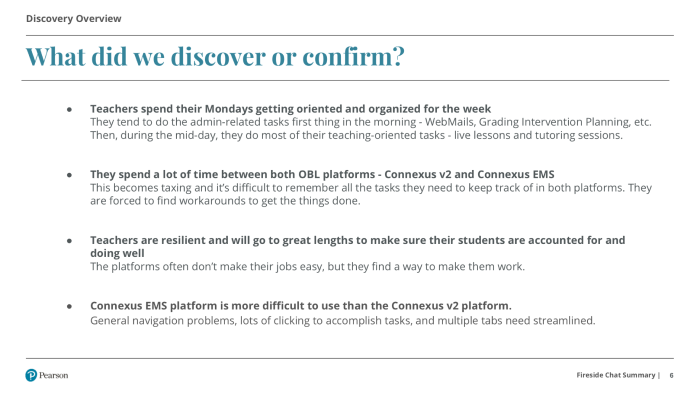Let's Talk
If you have a role or opportunity that sounds like a good fit, I'd love to hear from you. — Chris

Connections Academy Schools are tuition-free K-12 virtual schools—offered in 29 states serving more than 100,000 students throughout the United States. A division of Pearson Education.
The objective was to retain and increase student retention by improving the teacher's workflow within the learning management platform.
I partnered with Pearson's user research team to conduct qualitative user research with Connections Academy virtual K-12 teachers for this project.
Then, I shared the results with Pearson's development team. The research findings increased the number of features on the product road map to improve the user experience for teachers for the learning management platform.
For this project, I chose to conduct qualitative user interviews with K-12 teachers on various topics related to their workflow.
This included partnering with user research team, writing research plan, creating moderator script, session observation, research synthesis.
Within the Virtual School Division of Pearson, we were building a new version of the learning management platform that Connections Academy Schools and Districts used to operate their schools.
After working with product teams, I recognized a need to get qualitative feedback from teachers to understand their workflows and challenges. And to share these insights with those responsible for building the product—Product Managers, UX Designers, Engineers—so they can make informed product decisions.
If we could decrease the number of workflow issues teachers have, they can better serve each student's academic needs, which leads to better retention for the business.
My role was to lead the initiative and partner with Pearsons Global Research and Insights team to plan, conduct, synthesize and share the feedback within our product organization.
The scope included one focus group each quarter, with summary findings shared to product teams shortly after.
We recruited teachers using an existing distribution list. No budget or incentives were necessary since teachers were part of the Pearson organization.
Participants of the focus groups were Connections Academy K-12 Teachers. The intended audience for the results of the focus groups were internal product teams—Product Managers, UX Designers, and Software Engineers.
Get Project Approval: After working with product teams, I recognized the need for more qualitative user research. So I suggested the idea to the director of UX. Once approved, I reached out to Pearson's user research group to start the planning process.

Create a Research Plan: I partnered with Pearson's user research team to write a research plan outlining the research method, objectives, audience, moderator script, and scope. In addition, we identified significant workflow topics to focus on for each session—day in the life, teacher/student communication, grading & plagiarism.

Conduct Teacher Focus Groups: Coordinate and conduct qualitative remote focus groups with 6 to 8 K-12 teachers each quarter.

Synthesize Feedback: Synthesize the results of each focus group and share with Product Managers, UX Designers, and Software Engineers.

Share Out Findings: People within the product organization made daily decisions that impacted teacher workflow and efficiency. My goal was to inform the product org of the ongoing challenges teachers faced within the virtual platforms.

We conducted four focus groups with 6 to 8 teachers in each session by the end of the calendar year. We learned about teachers' typical day, how they communicate with students, grading & plagiarism.
I shared the findings with those responsible for building the virtual school platform. During Solutions Planning, product management used the feedback to influence future product road maps.
A pilot version of the platform was released to select schools for the 20/21 school year.
If you have a role or opportunity that sounds like a good fit, I'd love to hear from you. — Chris